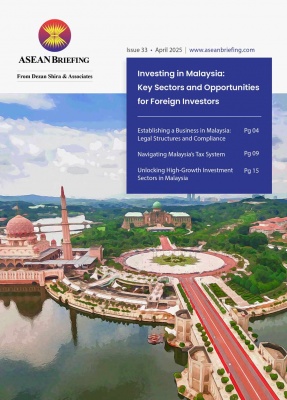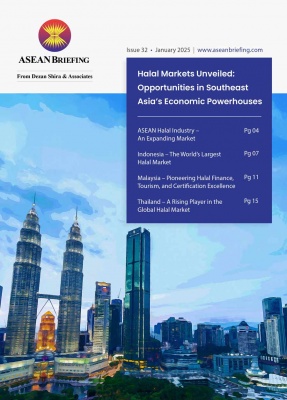EU-Vietnam Free Trade Agreement: Key Provisions and Implications for FDI
As the EU-Vietnam Free Trade Agreement (EVFTA) marks four years in August 2024, we review its implementation progress, highlighting key achievements and remaining challenges, to help businesses identify strategies to optimize their benefits from the agreement.
Alongside the Comprehensive and Progressive Agreement for Trans-Pacific Partnership (CPTPP), the EVFTA is considered one of the most crucial new-generation free trade agreements (FTAs) that Vietnam is part of. Notably, its signing demonstrated Vietnam’s commitment to enhancing trade relations with the European Union (EU) and addressing concerns over commercial activities and the business environment.
Overview of the EVFTA
Having entered into force on August 1, 2020, the EVFTA aims to stimulate economic growth between Vietnam and the EU by improving the investment climate and providing greater certainty for both European and Vietnamese investors.
To achieve its objectives, the trade agreement outlined a roadmap to:
- Eliminate customs duties, red tape, and other obstacles facing businesses;
- Streamline trade in key sectors, such as electronics, food products, and pharmaceuticals; and
- Open Vietnam’s market for EU service exports and vice versa.
Vietnamese traders have stood to benefit from the EVFTA in several ways, including:
- Eliminating 99 percent of all tariffs, with the remaining 1 percent being partially removed through limited zero-duty quotas;
- Reducing regulatory barriers and redundant bureaucracy;
- Protecting intellectual property rights, including geographical indications for special regional food and drink products;
- Catalyzing growth in services and public procurement markets; and
- Ensuring that the agreed-upon rules are enforceable.
EU-Vietnam trade after the EVFTA
Four years into the agreement, Vietnam has established itself as the leading exporter to the EU within ASEAN, driving economic growth, job creation, and greater consumer access to premium European products. According to the Ministry of Industry and Trade (MoIT), Vietnam’s export value to the EU has surged by nearly 50 percent, while imports from the EU have also grown by over 40 percent.
The gradual tariff elimination under the EVFTA has created mutual benefits, offering Vietnamese consumers more affordable, high-quality European goods while fostering the growth of export-oriented sectors.
According to the General Department of Vietnam Customs (GDVC), the two-way trade volume reached US$296.87 billion in 2023. For the first half of 2024, GDVC reported that Vietnam’s exports to the EU totaled over US$24.69 billion, marking an annual increase of 15.37 percent. Vietnam’s key exports to the EU included aquatic products, fruits and vegetables, footwear, apparel, wood, and wooden furniture, with the Netherlands, Germany, Italy, and Spain being the major importers.
Benefits for FDI in Vietnam
According to the European Chamber of Commerce (EuroCham), the EVFTA has significantly contributed to making the EU the sixth-largest source of foreign direct investment (FDI) in Vietnam, even though the EU-Vietnam Investment Protection Agreement (EVIPA) is still pending. EU members have invested €28 billion (US$30.6 billion) in 2,450 projects in Vietnam, many of which are high-quality investments in high-tech manufacturing and services.
The Ministry of Planning and Investment (MPI) projects that Vietnam will become more attractive to foreign investors due to its comprehensive commitments under the EVFTA. The benefits include:
- Smoother trade with greater freedom for service industries: FDI inflows from the EU to Vietnam will increase as EU service providers gain more opportunities from a more open service sector, particularly in business services, environmental services, postal services, banking, insurance, and shipping.
- New momentum for high-quality investments: The involvement of developed EU economies provides Vietnam with higher-quality investments, stimulating FDI inflows. Consequently, Vietnam's investment structure will experience significant changes as new partners enter novel investment areas, offering more opportunities for EU investors in sustainable industries such as green and renewable energy.
- A more transparent and predictable business environment: The EVFTA supports Vietnam’s ongoing institutional and legislative reforms towards international standards. It promises to enhance the business environment with greater openness, transparency, and predictability, thereby promoting both domestic and foreign investment and facilitating cross-border transactions and services.
Understanding the EVFTA: Key highlights for businesses
The EVFTA is a comprehensive agreement consisting of 17 chapters, two protocols, and several attached memorandums, covering various aspects of commerce, including:
- Trade in goods;
- Services, investment liberalization, and e-commerce;
- Government procurement; and
- Intellectual property rights.
While grasping the full text may seem daunting, there are essential sections that businesses should focus on for a more accessible introduction to the agreement.
To explore the EVFTA in detail, businesses can utilize the following resources:
- For the full text, visit WTO Center at https://wtocenter.vn/ which provides the content in a user-friendly format with a table of contents to simplify navigation.
- For detailed guidance, the Access2Markets portal of the European Commission offers search tools for goods and rules of origin, services, investment, and procurement.
- Alternately, you can reach our Business Intelligence experts at Dezan Shira & Associates for any queries on utilizing the EVFTA to optimize your business growth potential and expand market reach. You may email your queries at vietnam@dezshira.com
Tariff removal
The EVFTA is expected to significantly boost Vietnam’s exports to the EU, particularly for products where Vietnam holds competitive advantages, such as agricultural and aquatic goods. Conversely, EU businesses will also benefit from reduced duties when entering the Vietnamese market.
The EU’s commitments:
- Upon the agreement’s entry into force, the EU will eliminate approximately 85.6 percent of import tariffs on Vietnamese goods, covering 70.3 percent of Vietnam’s export revenue to the EU.
- Within the next seven years, the EU will remove 99.2 percent of tariffs, accounting for 99.7 percent of Vietnam’s export revenue to the EU.
- For the remaining 0.3 percent of Vietnam’s export revenue, the EU will provide a tariff-rate quota, with the import tax rate set at zero percent within the quota.
Vietnam’s commitments:
- Upon the agreement’s entry into force, Vietnam will eliminate 48.5 percent of tariff lines, representing about 64.5 percent of its total import revenue.
- Within the next seven years, Vietnam will remove 91.8 percent of tariff lines, accounting for 97.1 percent of EU export revenue.
- After ten years, 98.3 percent of tariff lines will be eliminated, covering 99.8 percent of total import turnover.
- For the remaining 1.7 percent of tariff lines, Vietnam will apply a tariff-rate quota under its WTO commitments or follow a special roadmap to gradually remove tariffs.
How do we track the EVFTA’s tariff elimination roadmap?
Chapter 2 of the agreement addresses national treatment and market access for goods, and includes:
- Annex 2-A: Reduction or elimination of customs duties.
- Appendices 2-A-1 and 2-A-2: Tariff schedules of the EU and Vietnam.
- Other appendices and annexes on export treatments, such as Vietnam’s export duties schedule, specific measures by Vietnam governing the importation and exportation of goods, goods excluded from the definition of remanufactured goods, and treatments for motor vehicles, motor vehicle parts and equipment, and pharmaceutical/medical products and medical devices.
EVFTA’s tariff elimination roadmap:
- Refer to the appropriate tariff list:
- Appendix 2-A-1: Contains the EU tariff schedules for businesses established in Vietnam exporting goods to the EU.
- Appendix 2-A-2: Contains the EU tariff schedules for businesses established in the EU exporting goods to Vietnam.
- Determine the product’s dismantling category:
- Locate your product by its customs code or description in Column 2 of the Tariff Schedule. The corresponding category is listed in Column 4.
- Understand the dates of reductions:
- Annex 2-A details 10 coded categories for each stage of tariff reductions, ranging from immediate elimination to reductions spread over 11 equal annual stages.
- The first reduction occurred on August 1, 2020, the effective date of the EVFTA. Subsequent annual reductions take effect on January 1 of each following year.
- Calculate the custom duty’s interim rate:
- Rates of customs duties during interim stages must be rounded down to at least the nearest 10th of a percentage point.
- If the rate is in monetary units, the rounding should be down to at least the nearest 10th of one euro cent in the case of the EU.
- Refer to quotas:
- Businesses should consult Section B in Annex 2-A for quota details.
|
Category |
Equal Annual Stages |
Dates of Reduction |
|
A |
0 |
From August 1, 2020 |
|
B3 |
4 |
August 1, 2020 January 1, 2023 |
|
B5 |
6 |
August 1, 2020 January 1, 2025 |
|
B7 |
8 |
August 1, 2020 January 1, 2027 |
|
B9 |
10 |
August 1, 2020 January 1, 2029 |
|
B10 |
11 |
August 1, 2020 January 1, 2030 |
Source: France-Vietnam Chamber of Commerce and Industry (CCIFV)
Rules of origin
The rules of origin (RoO) specify that goods must originate from the EU or Vietnam to qualify for the EVFTA’s tariff reductions. These rules are outlined in Protocol 1, which concerns the definition of ‘originating products’ and the method of administrative cooperation under the EVFTA (hereinafter “Protocol 1”).
According to Protocol 1, products are considered to originate in the EU or Vietnam if they meet one of the following criteria:
- Products wholly obtained in the EU or Vietnam, as defined in Article 4 on wholly obtained products;
- Products made exclusively from materials originating in the EU or Vietnam; or
- Products made in the EU or Vietnam using non-originating materials, provided these materials have undergone sufficient working or processing by fulfilling the product-specific rules in Annex II. These rules include value-added criteria, changes in tariff classification, and specific operations.
Businesses must also comply with requirements related to insufficient working or processing and the non-alteration rule. There is some flexibility regarding tolerances and cumulation to help companies adhere to the product-specific rules.
Eligible goods must be accompanied by one of the following proof of origin documents:
- Certificate of Origin (CoO): Prepared according to the guidelines in Protocol 1.
- Declaration of Origin (DoO): For imports into the EU, a DoO is prepared by an approved exporter for any consignment, regardless of its value, or by any exporter for consignments where the total value does not exceed €6,000, as outlined in Protocol 1.
- Statement of Origin (SoO): For imports into Vietnam, exporters must prepare an SoO and register it in an electronic database in accordance with relevant EU legislation. Under this provision, the relevant government agency in the EU must notify Vietnam that such legislation applies to their exporters.
Mutual recognition of standards
To safeguard the health, safety, and environment of the signatory members of the EVFTA, the agreement includes several mutual recognition standards to promote trade between the EU and Vietnam, such as:
- Sanitary and Phytosanitary measures (SPS);
- Geographical Indications (GIs);
- Labor Standards; and
- Corporate Social Responsibility (CSR).
Promoting and protecting investment
To protect investor interests from both sides, the EVFTA establishes an independent Investment Tribunal System to address any commercial disputes. This system will serve as a permanent mechanism for resolving investment disputes among all the agreement’s members.
In line with the EVFTA, the Vietnamese government has committed to opening its economy to investments in the manufacturing sector across several key industries. This commitment is expected to enhance FDI in Vietnam, particularly from EU member states.
Intellectual property rights
Under the EVFTA, customs authorities are required to actively engage in the seizure of goods suspected of infringing intellectual property (IP) rights. They must also cooperate with rights holders in the investigation process, including providing relevant information for risk analysis.
Business perceptions and main obstacles
When studying the reaction of Vietnam’s stock markets to EVFTA-relevant events, experts recorded that the markets were significantly sensitive to the developments before the EVFTA entered into force. According to a research article published on February 29, 2024, some industries were negatively affected by the news, as the investing community was afraid the EVFTA would cause consumption to switch to imported brands, resulting in lower demand for local brands. In contrast, industry sectors that enjoy a lower cost of production showed a positive response to the events.
The research attributes the varying impact on sectors to industry characteristics, changes in competition levels due to new tariff structures, and the entry of new market players.
More recently, the EuroCham Business Confidence Index (BCI) survey revealed that nearly two-thirds of respondents experienced varying levels of benefit from the EVFTA. The proportion of respondents reporting moderate to significant advantages rose to 27 percent in 2024, up from 18 percent in 2023. Meanwhile, those who had not yet seen tangible gains decreased to about 25 percent in 2024, down from 31 percent in 2023.
The survey highlighted that “EuroCham members consistently cite tariff reductions, increased market competitiveness, and expanded market access as key benefits. Other advantages include streamlined supply chains, improved business transparency, and a stronger legal framework.”
However, it also identified current challenges in implementing the EVFTA, including:
- Complex regulatory requirements and insufficient recognition of international standards by local authorities;
- A lack of understanding of the agreement among stakeholders, coupled with customs valuation issues and opaque clearance procedures; and
- Technical barriers, particularly in certification and product testing.
Key takeaways
The EVFTA mandates commitments from both the EU and Vietnam to lower tariff barriers, enhance trade, and expand market access for high-quality investments. Despite these commitments, firms must navigate existing obstacles to fully leverage the EVFTA’s potential for their businesses. They should consider the following strategies:
- Enhance production strategy: Businesses should focus on boosting production capacity, engaging in deep processing, and strategically sourcing raw materials to meet EVFTA standards and improve overall competitiveness.
- Develop a strong brand: With low prices no longer being a strong competitive edge, businesses need to build a brand based on consumer trust and recognition. Companies should establish their presence in international markets, ideally through cross-border e-commerce platforms, and adapt their brand development strategies and production plans to align with EU technical standards and consumer preferences.
- Monitor tariff reduction timelines: Since tariff elimination for different products follows a roadmap extending over 11 years, firms must stay informed about these timelines to effectively plan their export and market expansion strategies.
- Understand mutual recognition of standards: In addition to tariff schedules and rules of origin, businesses should familiarize themselves with standards and regulations related to quality and safety for industrial goods, as well as sanitary and SPS standards for agricultural products and foodstuffs. It is also important to understand regulations on geographical indications, labor standards, and CSR.
This article first appeared on Vietnam Briefing, our sister platform.
About Us
ASEAN Briefing is produced by Dezan Shira & Associates. The firm assists foreign investors throughout Asia and maintains offices throughout ASEAN, including in Singapore, Hanoi, Ho Chi Minh City, and Da Nang in Vietnam, in addition to Jakarta, in Indonesia. We also have partner firms in Malaysia, the Philippines, and Thailand as well as our practices in China and India. Please contact us at asean@dezshira.com or visit our website at www.dezshira.com.



















